Last week’s local papers covered extensively the loss of another heritage home in Queens Park. The general consensus coming out of the stories was that it was a shame: a house with an historical character that should have been saved, but couldn’t be. There was much discussion about the reason why it could not be saved, that any municipality would have had some difficulty if they tried to enforce community standards of “heritage” on private landowners – setting themselves up for lawsuits, etc.
This is especially difficult in Queens Park, where much of the City’ inventory of historic homes is located, but where the traditional champions of heritage run up against those who are the strongest defenders of individual property rights, free enterprise, small government and avoiding bureaucracy and “red tape”.
The reality is, as suggested in the stories, it is logistically and legislatively difficult for any Municipality to protect the heritage quality of private homes. What isn’t difficult is to protect the natural heritage in the form of trees that exist on the same private property.
In the case of the currently-lamented 221 Third Ave, there were at least 5 significant trees on the lot. Two mature cypress trees shaded the front of the home, a gigantic incense cedar stood on the corner of the lot in the front yard, and two mature trees guarded the back corners: one an ornamental plum, one a large English hawthorn. All met the chainsaw the day after the house was demolished.
The home will be replaced in a few months – if the neighbours are lucky the builder will respect the heritage character of the surroundings – but those mature trees will take decades to replace, and if the buildings are constructed to their maximum allowable footprint, there may never again be trees of this scale on those lots again.
Tree Protection Bylaws are, in contrast to heritage building preservation, simple and defensible. In the same week that the chainsaws were at work in Queens Park, Burnaby was bolstering its Tree Protection Bylaw to increase the protection of these important components of their natural heritage and their community’s ecosystems.
The site at 221 Third Ave makes for an interesting case, tree-bylaw wise. With a well-developed Tree Protection Bylaw, the two cypress trees would likely be preserved. The landowner may apply to remove them, if they really could not be fit into the redeveloped lot, but they would have to pay a penalty for their removal, and plant compensatory trees- likely (since the trees were healthy) at a 2-for-1 ratio. So the developer would have the simple economic incentive to keep the trees or pay cash for their removal and re-planting, as subtle shift of the economics to encourage the protection of trees.
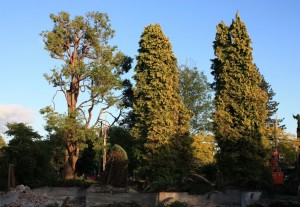 |
| Two large cypress trees on the right, incense cedar on the left, all now gone. |
The grand incense cedar in the front yard would, perhaps ironically, not be preserved. It is a large, historic tree, but it appeared to be not doing well. With generally sparse branches, little new growth, and a big crack up the middle of the trunk, an arborist would probably have no problem declaring the tree a hazard and approving its removal. In this case, the Landowner would not have to pay a fee for removal, but would still be required to replace the tree, in this case on a 1-for-1 basis, so the “net tree crop”of the City is not reduced.
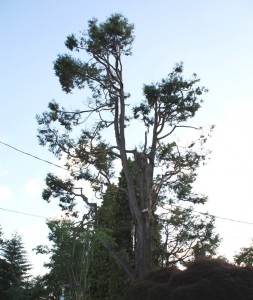 |
| Bad pruning, or just old age, this incense cedar was not long for this world. |
The two mature trees on the back corners would probably not be permitted for removal at all. Both were healthy, and were located very close to the property line where they would not interfere with eventual land development. The developer would have to plan the new buildings so they avoided disturbing these two trees, which would ultimately be not much of a hardship, considering their location.
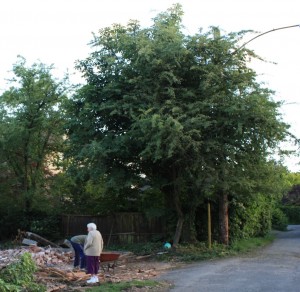 |
| This English hawthorn could use some pruning, but was healthy and worthy of preservation, and being right on the property line where it wouldn’t have hampered redevelopment of the site. |
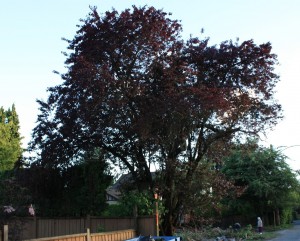 |
| Same story for this ornamental plum tree – it took decades to get this size, an hour to cut down. |
These trees in Queens Park were taken down almost two years to the day after New Westminster Council unanimously supported Councillor Lorrie Williams’ motion to develop a Tree Protection Bylaw. I attended that Council Meeting on behalf of the NWEP, asking why New Westminster remains one of the few jurisdictions in BC without such protection. Council seemed united, seemed to understand the issue, and passed a unanimous motion. Two years later: still no Bylaw.
How many more trees will go until we see action?
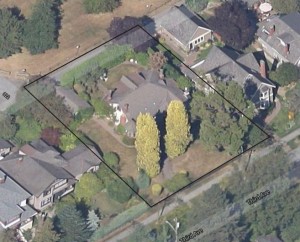
Or how many councillors will go before you see a tree bylaw…..
More trees – and not just just the drawf variety that seem to replacing the bigger trees that are being removed for fear on root damage to a sidewalk. I don’t think many people regret the beautiful trees that were planted in the 12th and Fraser area of Vancouver decades ago.